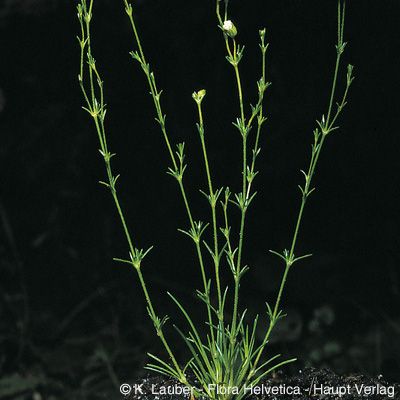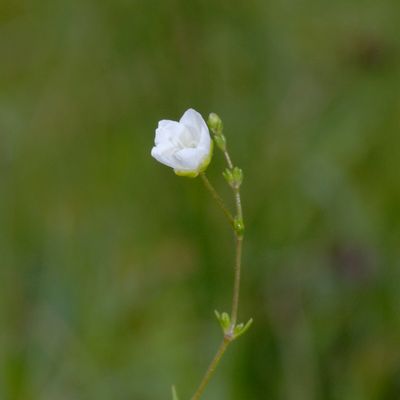Sagina nodosa (L.) Fenzl
1040460
Species
ISFS : 362100
Checklist : 1040460
ISFS : 362100
Checklist : 1040460
Contains :
Synthesis
Species description (© Flora Helvetica 2018)
5-15 cm hoch, niederliegend bis aufrecht, wenig verzweigt, kahl oder etwas drüsig. Blätter schmal-lineal, einnervig, die unteren 5-10 mm lang, die oberen viel kürzer, mit kleinen Büscheln in den Blattwinkeln. Blüten in lockerem Blütenstand auf dünnen Stielen, 5zählig. Kronblätter weiss, 1,5-2mal so lang wie die Kelchblätter. Diese 2-3 mm lang, mindestens die äusseren stumpf, ohne deutliche Nerven. Kapsel länger als der Kelch.Flowering period (© Flora Helvetica 2018)
7Habitat and distribution inside Switzerland (© Flora Helvetica 2018)
Sumpfwiesen, Torfmoore / kollin(-montan) / JS, früher SG (Bodensee)World distribution (© Flora Helvetica 2018)
Eurosibirisch-nordamerikanischEcological indicator (© Landolt & al. 2010)
4+w+42+43+1.c.2n=20-24,44,56Status
IUCN status
EndangeredNational Priority
3 - medium national priorityInternational responsibility
1 - weakConservation
Threats
Nutzungsänderungen (besonders Intensivierung oder Aufgabe der Beweidung)
Sukzession
Tritt
Entwässerung, Strassenbau
Eutrophierung
Z. T. kleine, isolierte Populationen
Distribution map
Habitat and distribution inside Switzerland
JS, früher SG (Bodensee)World distribution
Eurosibirisch-nordamerikanischEcology
Life form
Subfructicose chamaephyte
Habitats
Milieux Phytosuisse (© Prunier et al. 2017)
Habitats © Delarze & al. 2015
 | 2.5.1 - Einjährige Schlammflur (Zwergbinsenflur) (Nanocyperion) |
bold
Dominant species, influencing the appearance of the habitat
 Character species
Character species
 Less strictly linked to a specific habitat
Less strictly linked to a specific habitat
Ecological indicator values by © Landolt & al. (2010)
| Soil factors | Climatic factors | Salinity tolerance | |||
|---|---|---|---|---|---|
| Humidity Value H | 4+w+ | Light Value L | 4 | Salinity Index | 1 |
| Reaction Value R | 4 | Temperature factor T | 3+ | ||
| Nutriments value N | 2 | Continentality K | 1 | ||
- Ecological values legend
Humidity Value H 1 very dry 1+ dry 2 moderatly dry 2+ moist 3 medium wet 3+ wet 4 very wet 4+ soggy 5 submerged or underwater f plants living in running water u mostly submerged plants v partly submerged, partly floating plants w humidity moderately variable (± scale of 1-2) w+ highly variable humidity (scale exceeding ± 2) Reaction Value R 1 Very acid (pH 2.5-5.5) 2 acid (pH 3.5-6.5) 3 lightly acid to neutral (pH 4.5-7.5) 4 neutral to basic (pH 5.5-8.5) 5 basic (pH 6-5 -> 8.5 Nutriments value N 1 very low in nutrients 2 low in nutriments 3 medium-poor to medium-rich in nutrients 4 rich in nutriments 5 very rich in nutriments Salinity tolerance 1 halotolerant 3 halophyle Light Value L 1 very shady 2 shady 3 lighted areas 4 luminous 5 highly luminous Temperature factor T 1 alpine to nival stages (from the treeline to the snowline) 1+ suprasubalpine and upper subalpine levels (pine and larch forests) 2 subalpine level (coniferous forests without beeches up to the upper limit of spruces) 2+ lower subalpine and upper mountain stages 3 mountain level (beech and silver fir forests, in the central Alps Scots pine forests) 3+ lower mountain and upper hill levels 4 hill level (mixed deciduous oak forests) 4+ hot places, hill level 5 very hot places, hill level (only in the hottest places, typical of southern Europe) Continentality K 1 Atlantic (high air humidity, very low temperature variations, mild winters) 2 Sub-Atlantic (high air humidity, low temperature variations, relatively mild winters) 3 sub-Atlantic to subcontinental (average air humidity, moderately variable temperature, slightly low winter temperatures) 4 subcontinental (low air humidity, large temperature variations, rather cold winters) 5 continental (very low air humidity, very large temperature variations, cold winters)
Water dependency
| Rivers | 1 - Secondary habitat |
| Calm water | 1 - Secondary habitat |
| Ground water | 0 - No link |
Nomenclature
Accepted Name (Checklist 2017)
Sagina nodosa (L.) Fenzl
Vernacular name
Deutscher Name :
Knotiges MastkrautNom français :
Sagine noueuseNome italiano :
Sagina nodosaMatch with other reference books
| Relation | Nom | Book | No |
|---|---|---|---|
| = | Sagina nodosa (L.) Fenzl | Checklist 2017 | 362100 |
| = | Sagina nodosa (L.) Fenzl | Flora Helvetica 2001 | 341 |
| = | Sagina nodosa (L.) Fenzl | Flora Helvetica 2012 | 1200 |
| = | Sagina nodosa (L.) Fenzl | Flora Helvetica 2018 | 1200 |
| = | Sagina nodosa (L.) Fenzl | Index synonymique 1996 | 362100 |
| = | Sagina nodosa (L.) Fenzl | Landolt 1977 | 1046 |
| = | Sagina nodosa (L.) Fenzl | Landolt 1991 | 910 |
| = | Sagina nodosa (L.) Fenzl | SISF/ISFS 2 | 362100 |
| = | Sagina nodosa (L.) Fenzl | Welten & Sutter 1982 | 283 |
= The taxon corresponds to the accepted taxon (Checklist 2017)
< The taxon is included in the accepted taxon (Checklist 2017)
> The taxon includes (among others) also the accepted taxon (Checklist 2017)
< The taxon is included in the accepted taxon (Checklist 2017)
> The taxon includes (among others) also the accepted taxon (Checklist 2017)
Status
Native status
-IUCN list of endangered species (© Walter & Gillett 1997) : No
Status on national Red List 2016
IUCN status:
Endangered

Additional information
IUCN criteria: B2ab(iii)
Status on regional Red List 2019
| Biogregraphic regions | Status | IUCN criteria |
|---|---|---|
| Jura (JU) | EN | B2ab(iii) |
| Mittelland (MP) | RE | |
| Alpennordflanke (NA) | RE | |
| Alpensüdflanke (SA) | -- | |
| Östliche Zentralalpen (EA) | -- | |
| Westliche Zentralalpen (WA) | -- |
- Legend
EX Extinct RE Regionally Extinct CR(PE) Critically Endangered, Probably Extinct CR Critically Endangered EN Endangered VU Vulnerable NT Near Threatened LC Least Concern DD Data Deficient NE Not Evaluated NA Not Applicable
National Priority Species List Status
| National Priority | 3 - medium national priority |
| Need to take action | 2 - |
| International responsibility | 1 - weak |
| Need to monitor populations | 2 - |
Protection status
| International (Bern Convention) | No | |
| VD | total protection | (02.03.2005) |
| Switzerland | -- |
- Disclaimer
InfoFlora compiles information on protected species as accurately as possible, taking it from the respective cantonal laws. In some cases, however, it was not possible to use the plant names as listed in the original text, but an interpretation of their taxonomy or nomenclature was necessary. The exact meaning of the categories „completely protected“ and „partially protected“ differs among the cantons.
InfoFlora cannot guarantee that the information on the protection status is correct and complete. In case of doubts, we recommend to look up the texts of the respective cantonal law.
Status by sector of activity
| Agriculture-related environmental objectives : | more informations | |
| Forest management environmental objectives : | more informations |
Conservation
Threats and measures
Nutzungsänderungen (besonders Intensivierung oder Aufgabe der Beweidung)
Gegenwärtige Nutzung beibehalten
an einigen Fundorten Nutzungsintensität überprüfen
Randgebiete potentiell günstiger Sumpfwiesen und Flachmoore nahe aktueller Fundstellen extensiv beweiden (sofern mit anderen Schutzzielen vereinbar)
Sukzession
Besonders in Schutzgebieten (falls keine Beweidung) z. B. von Hand günstige erdigoffene Bereiche schaffen
Tritt
Falls Tritt zu stark etwas extensivieren
evtl. Zäune versetzen, damit das Vieh auch auf weniger nasse Bereiche ausweichen kann (aber etwas Tritt ist überlebenswichtig!)
Entwässerung, Strassenbau
Bestehende Fundstellen erhalten
allfällige Projekte anpassen
Eutrophierung
Direkte Einzugsbereiche nicht düngen
Pufferzonen einrichten
Z. T. kleine, isolierte Populationen
Schutz der Fundstellen (Mikroreservate)
regelmässige Bestandeskontrollen
ex-situ-Vermehrung veranlassen

